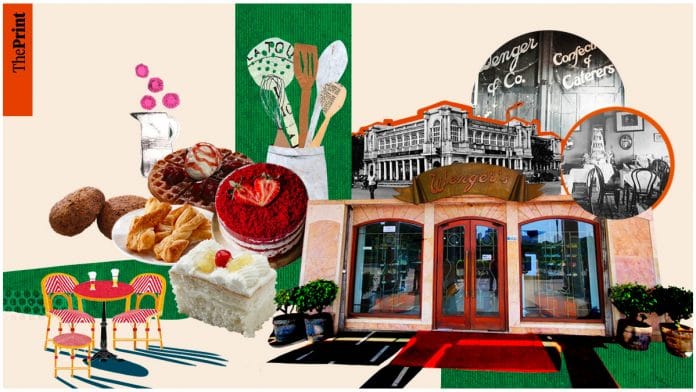Recently, while shooting for a film in Delhi’s Connaught Place, actor Arjun Kapoor couldn’t resist entering a bakery for a quick bite of his favourite snacks. And sure enough, half of Connaught Place landed up in the wide corridor outside Wenger’s to watch the actor gorge on pastries and patties. The bakery does not advertise itself — it runs on word-of-mouth goodwill and nostalgia. Situated at the same spot in Connaught Place where it shifted base from Kashmere Gate more than 70 years ago, Wenger’s is a landmark address in what used to be the most fashionable shopping site in the newly-constructed imperial capital of Delhi.
“The new imperial capital at Delhi did not develop from a small market town as do almost all other ancient cities of India, and indeed as Shahjahanabad did from its epicentre at Chandni Chowk. Nor did it come up on any important trade route. Instead, it was planned as the Viceroy’s seat of power by the officers of [British] Raj and was designed according to a town plan. And so, a marketplace was already a part of the initial drawings of W.H. Nicholls,” wrote Andreas Volwahsen in his 2002 book Imperial Delhi.
To maintain symmetry and not jar the larger town plan, Nicholls, the Delhi architect between 1913 and 1917, saw the need to build a circular arcade.
“By the time all the plots around the circle were demarcated in 1928, Nicholls had left. His successor, R.T Russell, worked on detailed drawings to create the beautiful circular shopping arcade, later called Connaught Place,” wrote Malvika Singh in her 2009 book New Delhi, Making of a Capital.
Also read: Lion beer to Old Monk rum—Mohan Meakin first to give India ‘coming-of-age’ drinks
Rooted in glamour
The elegantly understated classicism of Connaught Place, accentuated by the double-storied buildings with tall windows, made this place a magnet for shoppers and soon eclipsed all other market places in Delhi. Indeed, from the time its first shops opened, Connaught Place has always been full of hustle and glamour. Wenger’s, set up in the very first block of the market, was one of the most popular shops. It was started by the Wengers, a Swiss couple who purchased the shop from Sir Shobha Singh, one of the chief contractors who built the Rashtrapati Bhavan and surrounding areas. Interestingly, the original sale deed did not mention any address because, at the time of purchase, Connaught Place blocks had not yet been named or numbered.
Before coming to Connaught Place in the late 1920s, Wenger’s was set up at Kashmere Gate in 1926 and provided bakery items to British army personnel and troops. After shifting base to the heart of Delhi, the Swiss couple also opened a cafe and restaurant that included a ballroom as well. This attracted a lot of British officers, diplomats, Indian royalty, and upper-crust Indian business people. In 1944, the Wengers sold the business to Brij Mohan Tandon who used to work under them.
Also read: Trevillion & Clark taught Indian men western wear. Mohanlal Sons took over, turned to…
Passion project for an Indian family
Wenger’s soon became a passion project for Tandon, and his three sons — Raghuvir Singh, Om Prakash, and Anup Kumar — got involved in running the bakery. “My grandfather Brij Mohan ji was born in Delhi, so we are an old Dilliwala family,” says Aman Tandon who now runs Wenger’s with his cousin Atul Tandon.
And this bakery soon became a calling for the Tandon family members.
“After my studies, I thought a lot about which courses to attend, and I did some courses in London, but, ultimately, for me, it was always Wenger’s. My father Anup Tandon lovingly took matters into his hand and said ‘main sikhaunga’ (I will teach you),” recalls Aman.
Aman’s father knew that a professional bakery course might train one in different skills, but traditional family recipes could only be learnt in a family establishment. And Aman learnt from ‘table to table’ as bakers say. Aromatic bread of different flours and herbs, crumbling soft puff pastries, patties with delectable stuffings, and airy souffles – all items at Wenger’s follow the tried and tested family recipes.
“Almost all our customers are committed old-timers who keep coming back for a familiar and comforting taste. The reason Wenger’s products make everyone feel nostalgic is that we avoid processed materials. Almost all modern bakeries use ready-made mixes for sauces, syrups, and use synthetic creams. But we make our own sauces and syrups with raw ingredients – and use organic full cream, just as we always used to in our old recipes,” Aman adds.
He says that they have noticed a lot of change in people’s palettes, so some popular items like sugar pastry have gone off the shelf now. “But we continue to make our classic cream roll, pineapple pastry and éclairs just as we used to make them earlier. Now, people expect a different look and feel because everyone’s taste is so heavily influenced by the internet and new trends. We earlier had no more than 12 varieties of pastries – today we have a repertoire of over 200. We now offer an array of savoury and sweet items, including customer favourites such as shami kebabs, waffles, and red velvet cakes.”
Contemporary bakeries use very intense flavours to grip your taste buds at the first bite, but at Wenger’s, they prefer subtle flavours and lingering aromas, according to Aman.
This commitment to consistency has been passed down from generation to generation with a sole focus to maintain quality over expansion and franchising. This is the key reason why there is only one Wenger’s – the original one.
This article is a part of a series called BusinessHistories exploring iconic businesses in India that have endured tough times and changing markets. Read all articles here.






